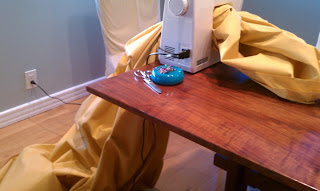This project is a huge pain in the ass. I'm not finished yet, but thought I'd share what is done so far and how I did it in an effort to restore my enthusiasm. If nothing else, this project has done its job of keeping me occupied and off the Internet.
Let me begin with a warning: do not do this. Or, okay, do it, but only if you really cannot afford a new couch. I should have just bought new furniture (yes, wasteful, but dear lord! Way easier). I guess if you are a great seamstress and have endless free time and no kids or no need to sit on the sofa in question for days and days then, sure, you can give it a go. Otherwise, seriously, Pottery Barn is your friend.
This is how 40 yards of 54" fabric is shipped to you from
Fabric.com:
 |
| I'm only 5 feet tall. This is nearly a third of my body weight. Awkward isn't really strong enough of a word. |
If you follow any sort of "real" directions you will at this point be measuring out everything before cutting. The math worksheets inside
"Custom Slipcovers Made Easy" ought to earn you college credit. At least a unit. Needless to say I did not do any of that. Instead, I followed the
"Lazy Girl's Guide to Custom Slipcovers" and just did some draping and cutting.
 |
| Down the back I have a good 2.5 inches onto the floor. I regularly have my couch vacuumed and steam cleaned because that's how I am, but I realize that is not typical so remember to vacuum and clean well before you start because you don't want to be doing it in the middle. |
Since the fabric is a solid color I just railroaded it which makes things much simpler. If this is your first slipcover (like me) DO NOT choose a pattern. Just don't. It is already enough work. Remember you want to drape the fabric inside out. The backside of my fabric is a bit lighter then how it will actually look.
 |
| More draping and pinning. In this photo four sections: outside back, right arm over, inside back and bench. Cushions are removed in this photo and I believe were being made into fortresses in front of the TV at this point. |
Instead of draping the inside back all the way down onto the bench I put a seam between the bench and the inside back. My reason for doing this is that my bench could then drape all the way to the floor without a skirt. Ruffles aren't really my style. The important note here is that you have to make sure the bench piece is wide enough to wrap around the outside to meet with the side pieces (not in the above photo yet). You'll have to trim quite a bit around the inside arms, but it will be better then having to piece together yet another bit of fabric.
 |
| All these pins are wrong. Every single one. |
Here is a
tip for beginners that ought to be tattooed on my face:
RIGHT SIDES TOGETHER. I pinned across the back and along the inside arms before realizing I'd pinned it wrong. Yeah. That was rough. I was too busy trying to get it straight and tight. A stupid mistake that cost me a chunk of time. Another hint: you will pin your hands. It will hurt. Drink wine. It will help.
I used something like 300 pins. My fancy magnetic pin cushion was worth the investment. I love mine! I can't imagine what I would have been doing without it. Individually poking them into my standard tomato? No thanks.
"Lazy Girl's Guide" is skimpy on some details which becomes evident once you are trying to fit the fabric around curves and along angles. I had to make darts along the corners which wasn't difficult or anything- just wasn't in the directions. This is where the overwhelming detail and complicated techniques in the "Slipcovers Made Easy" book are helpful in pointing you in the right direction. Not that I was going to be doing faux-box corners or anything, but at least I knew I wasn't crazy that it wasn't looking right without the darts.
 |
| Cutting bias strips is difficult since my cutting table isn't actually wide enough to cut 42" fabric at a full 45 degree angle. I cut half than flipped the fabric and cut the other half. It worked. Don't use disappearing ink as it'll be gone before you get to cutting. Use tailors' chalk. |
After that initial bout of pinning, I needed to pin the arm fronts which I needed welting in order to complete. I considered making the welting the easy way, just folding fabric straight over cording, but in the end decided that I was going to make it the right way, encased in bias cut strips that were pieced together one at a time. I did try to figure out how to make continuous loop bias tape to save some effort, but after watching video after video on YouTube I was still confused and so nixed that too. I did use my rotary cutter for the first time since I failed with it early last year. They were using rotary cutters in all of the videos so I picked up some tips on how to use them properly, if not how to make the loop. Kind of in love with it now.
Another totally awesome tool to use when making your own welting or piping is this do-dad:
 |
| My bias strips are two inches (roughly, even with the rotary cutter some are a little straighter then others) and the cord is cotton piping in size 8/32. The 4th grade math student in me so wants to reduce that number properly. |
The do-dad is magnetic so sticks to the base plate and pushes the cording up along the zipper foot nice and tight. I have zero idea when or why I purchased it, or what it is really called, I just happened to find it among my notions while searching for my zipper foot and was pretty stoked I had it. It will also help you gather pins when you leave the magnetic pin cushion in the other room. FYI.
 |
I made 7.5 yards of finished welting. The whole process, cutting bias strips and sewing, took me about 3 hours. I will need to make an additional 20 yards for the cushions and then double the whole amount for the second couch. Yeah. That should be 10-12 hours of work I imagine.
I then pinned the fronts to the arms inserting the welting along the seams. I cut into the arm drape where I wanted to run the welt horizontally across the side of the couch. That was unnerving since I'd already pinned the inside of the arm to the bench and inside back and was concerned I'd mess it up and have to re-do all the work.
This eats up pins like crazy.
After all the pinning it is finally time to sew. Now in "Lazy Girl's Guide" she bastes all the seams by hand before taking it to her machine. That sounded like a good plan to me so I tried it. Terrible. I don't know what I did wrong, but something was not right. I kept snapping the thread and was really burned out with the whole effort. I quit basting after one one arm. Maybe I should have taken a break.
In "Sewing Made Easy" she doesn't baste, but does outline with marker where she wants the seams. The problem with that is you have to plan ahead of time how you intend to put the fabric through the machine which spatially I cannot do. Unless she was doing it on both sides of the future seam? Maybe that would have worked. Anyway, I said screw it and dragged the pinned mess to my dinning room.
This was difficult. And all kinds of disastrous. There is simply way too much fabric! A tip for beginners (that I will be using on the second slipcover): pin one seam at a time, sew, check the fit, then pin the next seam, sew, check the fit, repeat-repeat-repeat. It may seem more time efficient to pin all at once and then sew it all at once, which it may very well be, but don't do it if you don't know what you are doing.
Completely exhausted, I turned it right side out and put it on the couch. It did not fit well and I had bunching where I'd sewn through two layers on accident in several places. I did not take a picture because I was pretty sure I was going to give up. Wish I had now. (Taken photos, not the giving up.) I talked myself into trying to fix it after a couple of days of moping. I had to rip out and re-pin a bunch of seams, all of them along the arms.
 |
| Cushions back on the couch. We use this room on a daily basis for hanging out and watching TV, playing games, etc. It being off limits for an extended period of time was not possible so we just used while pinned up. |
You can see how much brighter the yellow and dark coral will make the room. One day. Far, far in the future.
Part 2 will be the cushions and I hope to do them this week. We'll see how it goes with my time. And then, of course, I have to do the second couch. Good grief!
Linkys:


|




















